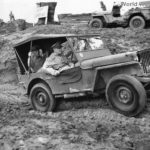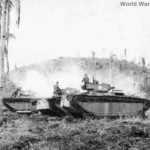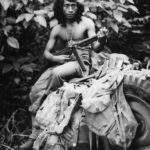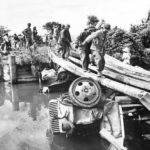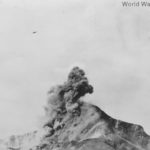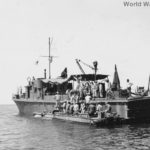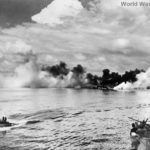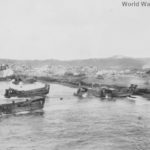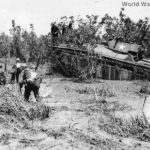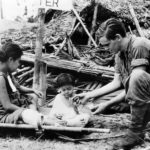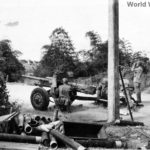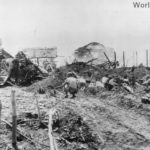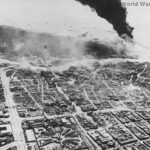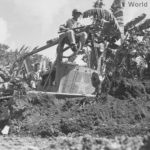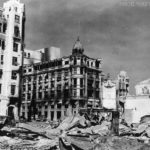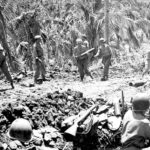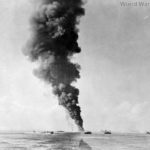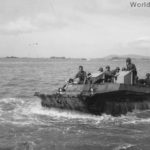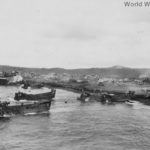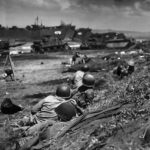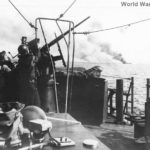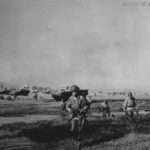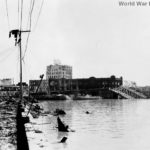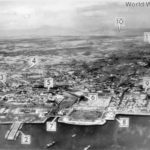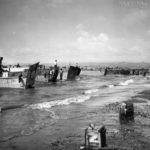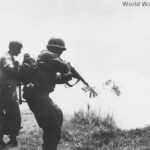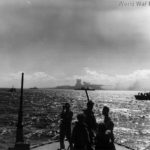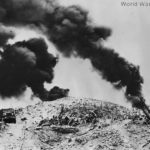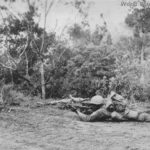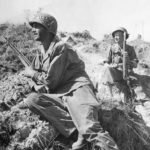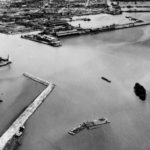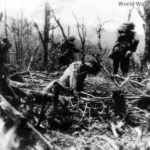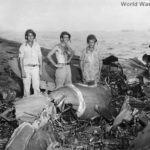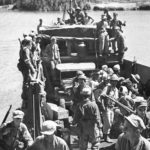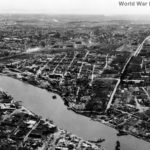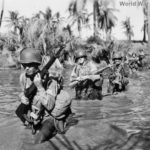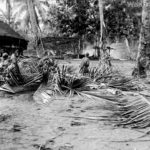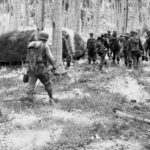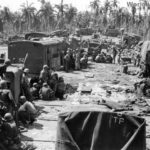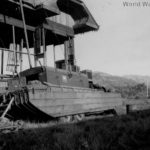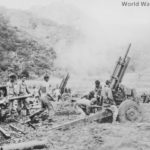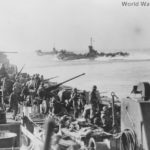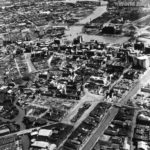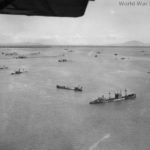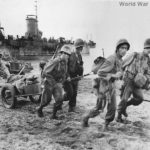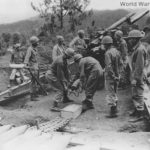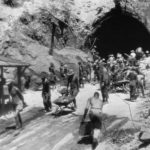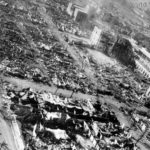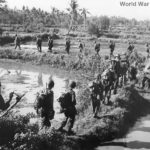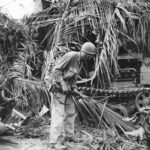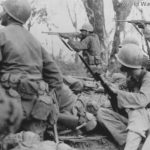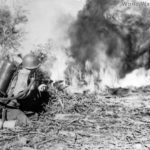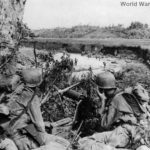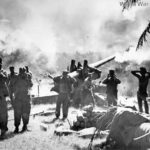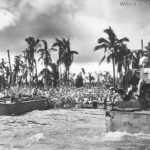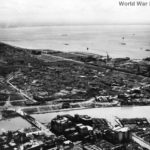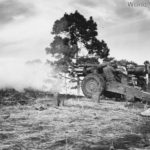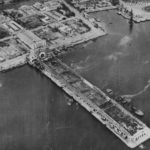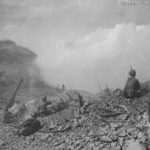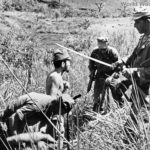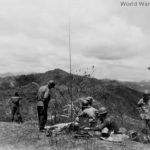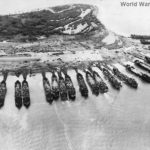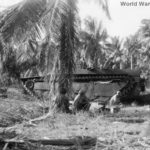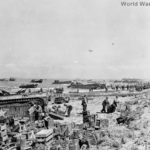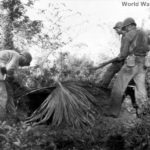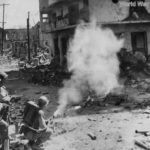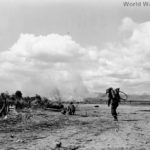Gen MacArthur riding in Jeep at Jeep Landing on Leyte 1944
Soldiers atop LVT(A)-4 “Alligators” in action at Hill 120 on Leyte
Philippine Guerrilla scout operating with 24th Division Recon Squad Mindanao
U.S. 59th Coast Atrillery troops at Battery Geary on Corregidor
Troops use wrecked trucks to build bridge on Luzon
Bombing Hill 1700 Bamban February 1945, Luzon
1st Cavalry Division assaults a Japanese held village in Philippines
U.S. Army LVT(A)-1 Alligators landing from LSTs on Leyte Beach
Armored bulldozer at work as troops land on Luzon Beach, Lingayen 1945
DUKW transfers wounded to QS-2 Ship Mindanao 1945
Smokescreen laid around U.S. Navy ships during Invasion of Leyte 1944
37th Division troops at Shattered City Hall in Manila
LSTs and LCTs beach landing Port Legaspi, January 1945
soldiers get Help from LVT(A)-4 during advance on Leyte 1944
US Soldier gives child candy at Navy Evacuation Center on Leyte 1944
40th Infantry Division troops, USS LCI(L)-1064 and USS LCI(L)-1018, beach at Pulupandan, Phillipines
Para bombs dropped on Clark Field 1945
US Forces land by wrecked Japanese plane on Luzon Beach
U.S. Army 40th Infantry Division 57 mm Gun M1 in action
7th Division hunt Japanese snipers in the village of Dulag on Leyte
Aerial View of burning buildings during the Battle for Manila 1945
1st Cavalry Division troops mopping up on Leyte
511th Parachute Infantry strike japanese Appari airfield June 25, 1945
Troops in headed for Leyte invasion beach watch battle overhead
U.S. Army 40th Infantry Division sniper guard on bulldozer
Japanese soldiers, captured by 43rd Infantry Division, Philippines 1945
105 mm M2A1 battery in action January 1945, Battle of Luzon
The Ruins of Manila after the Battle for the Philippine Capital March 1945 7
32nd Infantry Division 6×6 trucks and 57mm AT guns, Mindanao 1945
The 41st Infantry Division on Mindanao
The Ruins of Manila after the Battle for the Philippine Capital March 45 2
U.S. Navy LSTs at Leyte Beach 2
US Navy planes blast Japanese warships in Manila Harbor
Troops move thru ruins of native village on Luzon 1945
The 41st Infantry Division on Mindanao 2
U.S. Navy LSTs at Leyte Beach
USS LST-169 Leyte Beachhead
USS LST-18, 245, 202 and 467 landing troops on Leyte 20 October 1944
LVT “4-7” on Calmy River Bridge Luzon 1945
Soldiers advancing under cover of LVT Amtrac on Luzon 1945
41st Division troops with Japanese dummy tank on Mindanao
US Army 40th Infantry Division coming ashore LVT, Pulupandan
41st Division Soldiers and Sherman moving inland on Mindanao 1945
58th IR troops, USS LST-932 and LCVP, Legaspi Amphibious Assault Luzon 1945
96th Infantry Division troops during Invasion of Leyte
LSTs Moving through China Sea enroute to Luzon Invasion 1945
Troops move thru Binmaley Area of Luzon 1945
Artillery in action Balete Pass near Santa Fe Luzon May 1945
Japanese Destroyer bombed Ormoc Bay March 1945
Coast Guardsmen shelter from Japanese fire on Luzon Beach
Gun crew in action on LCI during Invasion of Mindoro
GIs using phosphorous grenades Luzon Philippines 1945
U.S. Troops clearing Japanese suicide squad on Corregidor 1945
6th Army Troops landing on Beach of Leyte
Troops use tractors to free 155mm howitzer mired in mud on Luzon
US Army Lingayen Beach, Luzon 12 January 1945
37th Infantry Division Gis near Bambang, Luzon June 6, 1945
24th Infantry Division LVT Amtracs landing Mindanao
The Ruins of Manila after the Battle for the Philippine Capital March 1945 11
Airview of Manila showing where occupied by Japanese
Early wave landing craft invasion Luzon
129th Regiment troops near Aritao June 5, 1945
General Douglas MacArthur walks amid rubble on Corregidor 1945
February 16, 1945 bombardment of Corregidor by U.S. 7th Fleet
38th Division pipes oil into Japanese hideouts on Caballo Island
Firing at Japanese sniper 1945, Luzon
40th Division troops in action near Clark Field, Luzon 1945
The Ruins of Manila after the Battle for the Philippine Capital March 1945 3
1st Cavalry troops advance thru waist deep mire on Leyte
25th Division troops pass Japanese soldier impaled on tree Luzon 1945
USS LST-488 loaded with assault troops heading for shores of Luzon 1945
Caterpillar D4 tractors run landing lanes to LSTs on Leyte
Troops by Japanese plane that fell in their foxhole on Leyte
The 41st Infantry Division on Mindanao 3
The Ruins of Manila after the Battle for the Philippine Capital March 1945 6
43rd Infantry Division San Fabian January 10, 1945
The 41st Infantry Division on Mindanao 5
The Ruins of Manila after the Battle for the Philippine Capital March 1945 9
38th Division troops blast Japanese position on Luzon
The 41st Infantry Division on Mindanao 4
96th Division soldiers advance over Catamon Hill on Leyte
DUKW and Ford GPA in LST Philippines Invasion
U.S. troops advance through Swamp on Leyte
Manila downtown destruction Philippines
7th Infantry Division mortar squad in action on Leyte
Battered LST Leyte Beach, October 20, 1944
DUKW on cebu used as mobile radio command center
PT Boats stand by as Japanese bombs explode in Leyte Gulf
33rd Infantry Division 105 mm howitzer firing, Butac 10 June 1945
LCI head for Lingayen Gulf 1945
The Ruins of Manila after the Battle for the Philippine Capital March 1945 4
1st Cavalry troops land under Japanese fire on Leyte Beach
The Ruins of Manila after the Battle for the Philippine Capital March 1945 8
Soldiers and LVTs advancing in Binmaley Luzon 1945
GIs fire 75 mm Pack Howitzer M1 at Japanese, Negros
6th Army troops pull mortar ashore on Ormoc Beach
37th Infantry Division 155 mm Howitzer M1 in action near Baguio Luzon
Japanese POWs work at tunnel where US surrendered on Corregidor 1945
Low level bombing over Luzon January 1945
Patrol moving up near Damortis Luzon, 1945
The Ruins of Manila after the Battle for the Philippine Capital March 1945 1
Gen. MacArthurs troops advance near Binmaley on Luzon
Troops inspect knocked out Japanese tractor on Luzon
US Army GIs firing on bunker Cabaruen Hills January 1945
GI blasting Japanese position with flame thrower at Nanacag January 1945
77th Division crossing Antilao River at Ormoc Leyte 1945
US gunners shell Japanese with 155 mm Carigara
Dulag Beachhead D-Day Plus 3 Philipines 1944
Troops inspect wreckage of Japanese plane on Luzon
Japanese Judy shot down near U.S. cruiser during retaking of Philippines
Landing Craft from USS Callaway unload troops supplies on Leyte
The Ruins of Manila after the Battle for the Philippine Capital March 1945 10
Invasion force off Dulag October 22, 1944
USS LSM-258 unloads troops equipment on Ormoc Beach
US Army 40th Infantry Division 155mm artillery in action
American troops enter Bamban Luzon 1945
503rd Parachute Infantry landing at Zone B on Corregidor 1945
LST unloads trucks and ammunition under fire on Luzon
Clark Field burning after raid by US Navy planes
US Army 40th Inf LSTs jeeps San Fabian Philippines
GIs in Jolo Bomb crater under heavy machine gun Philippines 1945
U.S. Troops advance to Damortis Rosario Road on Luzon
Infantrymen crossing damaged Calmay Bridge on Luzon
Manila Pier 7 damaged by Japanese 1945
US troops on Carabao Island Battle of Luzon April 16, 1945
Japanese Officer surrenders sword to U.S. Forces Ipo Dam, Luzon
43rd Infantry Division fighting in the Philippines 1945 2
LSTs landing troops and equipment during Invasion of Leyte
Jeeps and LVTs loaded with invasion troops move inland on Luzon from Lingayen Gulf
8th Army troops pour off USS LCI(L)-447, USS LCI(L)-430 and wade ashore between San Narciso and San Antonio on the west coast of Luzon on 29 January 1945
Sgt Peter Kostares delivers mail to his buddies in Company K of the 25th Division along rough jugle trail at Balete Pass Luzon 1945
Soldiers and LVT of the 43rd Infantry Division fighting their way inland off White Beach 3, Lingayen Gulf 9 January 1945
Japanese soldiers captured by 43rd Infantry Division at Ipo Dam, Luzon eating their first American C-rations at a prisoner of war stockad 1945
PBYs drone overhead as General MacArthur’s invasion convoy moves into Lingayen Gulf to drop troops and supplies
43rd ID troops and LVT on Yellow Beach, Lingayen Gulf during the start of the invasion of Luzon Island 9 January 1945
Soldiers check a Japanese pillbox on Luzon as they move inland from beachhead on Lingayen Gulf 1945
Troops of the 37th Division use flamethrower to blast a Japanese pillbox in the Ermita District of Manila
Ships of the naval task force in the Central Philippines under heavy attack by Japanese bombers off Leyte Island
43rd Infantry Division flame thrower team advances under artillery fire during the capture of Clark Field 29 January 1945
The Philippines campaign of 1944–45 was the Allied campaign to defeat Japanese forces occupying The Philippines, during World War II. The invasion commenced on 20 October 1944 and hostilities continued until the war’s end.
By mid-1944, American forces were only 300 miles southeast of Mindanao, the southernmost island in the Philippines. Allied forces had advanced across the Central Pacific taking the Gilbert, Marshall and Caroline Islands. Carrier based planes were already conducting strikes against the Philippines. American and Australian ground forces under General Douglas MacArthur, Supreme Commander, Southwest Pacific Area, had isolated the Japanese in mainland New Guinea, and then isolated the huge Japanese base at Rabaul by capturing and creating air and naval facilities across the Southwest Pacific theater.
With victories in the Marianas campaign (Saipan, Tinian and Guam, June–July 1944), at Peleliu in the Palau Islands (Aug–Sep 1944), and Battle of Morotai (15–16 September 1944), Allied forces were getting close to Japan itself. From the Marianas, U.S. Army Air Forces could bomb the Japanese home islands for the first time during the war. Although Japan was obviously losing the war, they showed no sign of capitulation or collapse.
Because of the close relationship between the Philippines and the United States since 1898, the decision was made to advance the date for the long-awaited return to the Philippines. The new date would be 20 October 1944, two months ahead of the previous target date. The Filipinos (people of the Philippine islands) were ready and waiting for the invasion. After General MacArthur was evacuated from the Philippines in March 1942, the islands fell to the Japanese. The Japanese occupation was harsh, accompanied by atrocities and with large numbers of Filipinos pressed into forced labor. During 1942-1944, MacArthur supplied the Filipino guerrilla resistance by submarine and airdrops, so they could harass the Japanese and keep control of the rural jungle and mountain areas, more than half of the country. While loyal to the U.S., many Filipinos hoped and believed that liberation from the Japanese would bring freedom and an independent country.
The Australian government offered MacArthur the services of I Corps of the Australian Army for the Philippines campaign. MacArthur suggested that two Australian divisions be used, each attached to a different US corps, but this was not acceptable to Australian leaders, who wanted significant operational control within a particular area, rather than simply supporting a US corps. As a result, the Australian Army played virtually no part in the campaign. However, many units from the Royal Australian Air Force and Royal Australian Navy were involved.
Leyte
On 20 October 1944, the U.S. Sixth Army, supported by naval and air bombardment, landed on the favorable eastern shore of Leyte, one of the three large Philippine Islands, north of Mindanao. The Japanese miscalculated the relative strength of forces and attempted to destroy the landing through a major sea battle in Leyte Gulf, fought on 23–26 October. The decisive naval battle nearly eliminated Japan as a major sea power and only encouraged the invasion of Leyte.
The U.S. Sixth Army continued its advance from the east, as the Japanese rushed reinforcements to the Ormoc Bay area on the western side of the island. While the Sixth Army was reinforced successfully, the U.S. Fifth Air Force was able to devastate the Japanese attempts. In torrential rains and over difficult terrain, the advance continued across Leyte and the neighboring island of Samar to the north. On 7 December 1944, U.S. Army units landed at Ormoc Bay and, after a major land and air battle, cut off the Japanese ability to reinforce and supply Leyte. Although fierce fighting continued on Leyte for months, the U.S. Army was in control.
Luzon
On 15 December 1944, landings against minimal resistance were made on the southern beaches of the island of Mindoro, a key location in the planned Lingayen Gulf operations, in support of major landings scheduled on Luzon. On 9 January 1945, on the south shore of Lingayen Gulf on the western coast of Luzon, General Krueger’s Sixth Army landed his first units. Almost 175,000 men followed across the twenty-mile beachhead within a few days. With heavy air support, Army units pushed inland, taking Clark Field, 40 miles northwest of Manila, in the last week of January.
Two more major landings followed, one to cut off the Bataan Peninsula, and another, that included a parachute drop, south of Manila. Pincers closed on the city and, on 3 February 1945, elements of the 1st Cavalry Division pushed into the northern outskirts of Manila and the 8th Cavalry passed through the northern suburbs and into the city itself.
As the advance on Manila continued from the north and the south, the Bataan Peninsula was rapidly secured. On 16 February, paratroopers and amphibious units assaulted Corregidor, and resistance ended there on 27 February.
Despite initial optimism, fighting in Manila was harsh. It took until 3 March to clear the city of all Japanese troops. Fort Drum, a fortified island in Manila Bay near Corregidor, held out until 13 April, when a team went ashore and pumped 3,000 gallons of diesel fuel into the fort, then set charges. No Japanese survived the blast and fire.
In all, ten U.S. divisions and five independent regiments battled on Luzon, making it the largest campaign of the Pacific war, involving more troops than the United States had used in North Africa, Italy, or southern France.
End
Palawan Island, between Borneo and Mindoro, the fifth largest and western-most Philippine Island, was invaded on 28 February, with landings of the Eighth Army at Puerto Princesa. The Japanese put up little direct defense of Palawan, but cleaning up pockets of Japanese resistance lasted until late April, as the Japanese used their common tactic of withdrawing into the mountain jungles, dispersed as small units. Throughout the Philippines, U.S. forces were aided by Filipino guerrillas to find and dispatch the holdouts, the last of which Hiroo Onoda did not surrender until 1974.
The U.S. Eighth Army then moved on to its first landing on Mindanao (17 April), the last of the major Philippine Islands to be taken. Mindanao was followed by invasion and occupation of Panay, Cebu, Negros and several islands in the Sulu Archipelago. These islands provided bases for the U.S. Fifth and Thirteenth Air Forces to attack targets throughout the Philippines and the South China Sea.
Following additional landings on Mindanao, U.S. Eighth Army troops continued their steady advance against stubborn resistance. By the end of June, the enemy pockets were compressed into isolated pockets on Mindanao and Luzon where fighting continued until the Japanese surrender on 2 September 1945.
